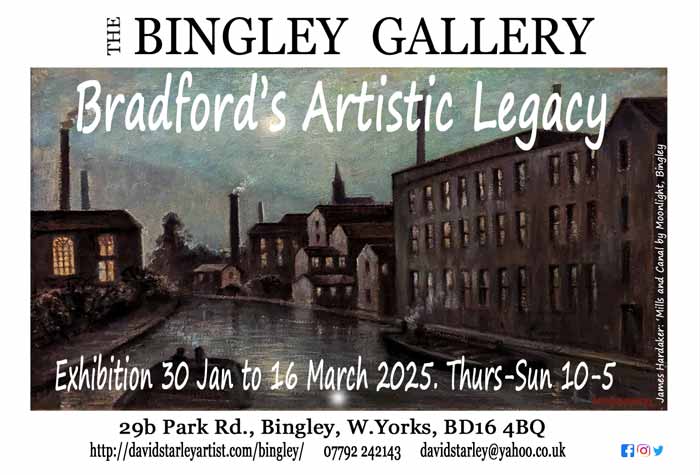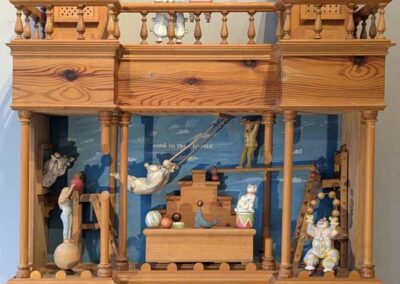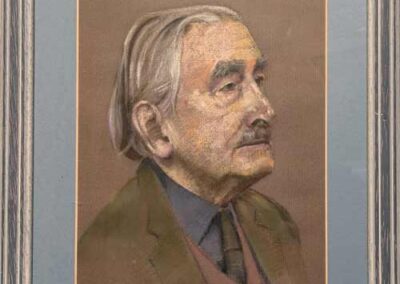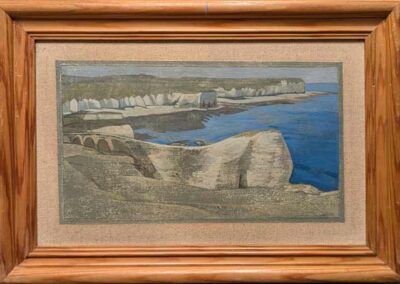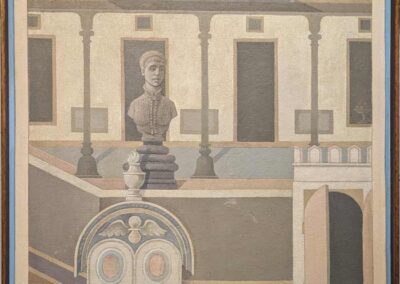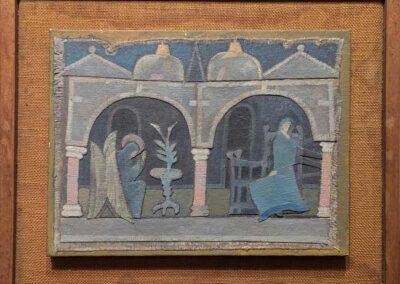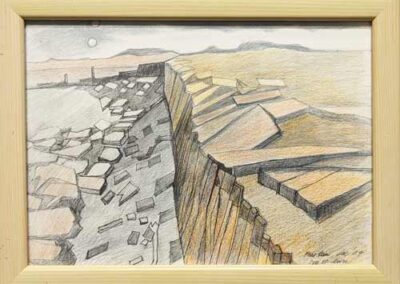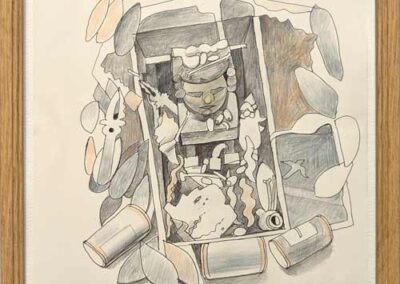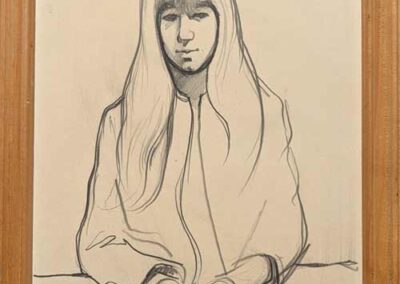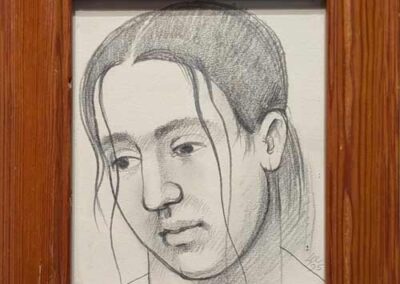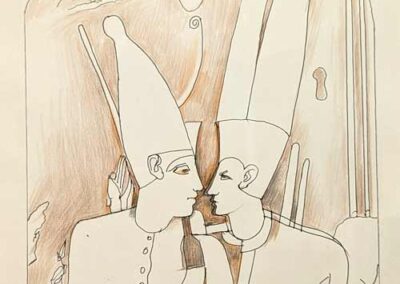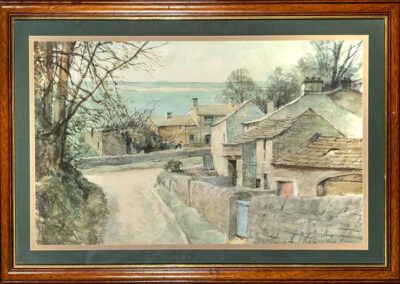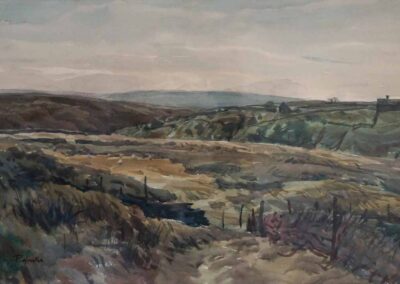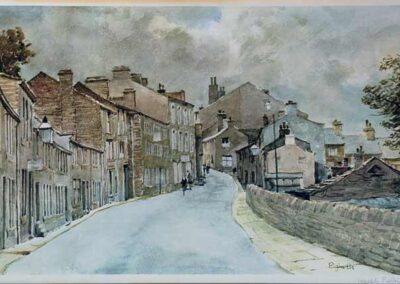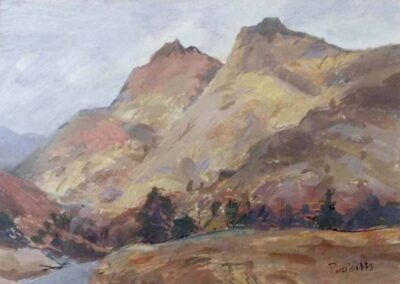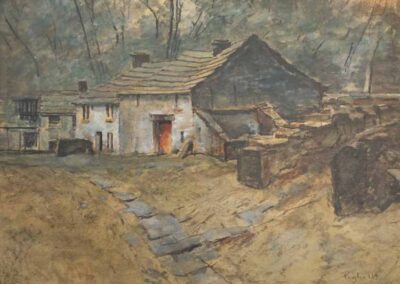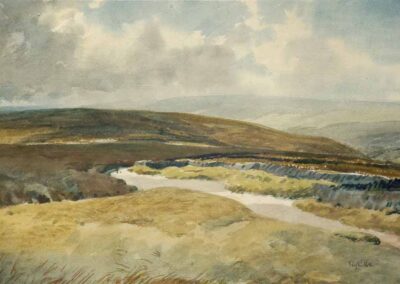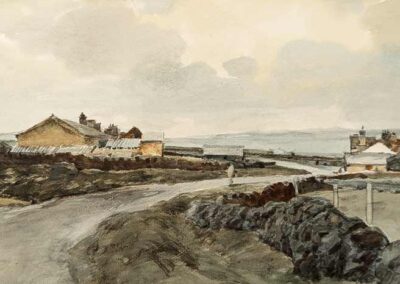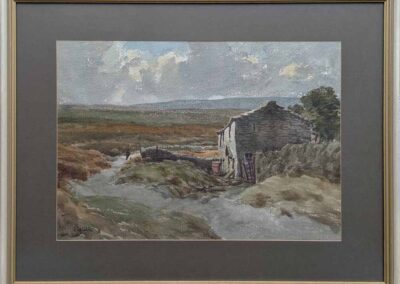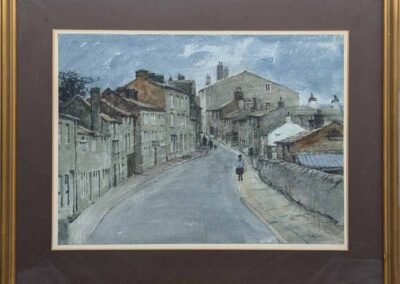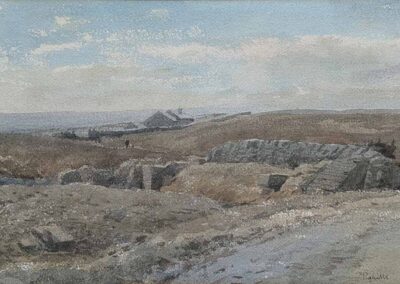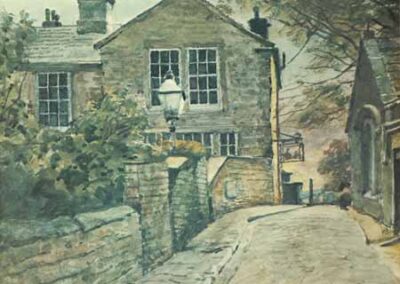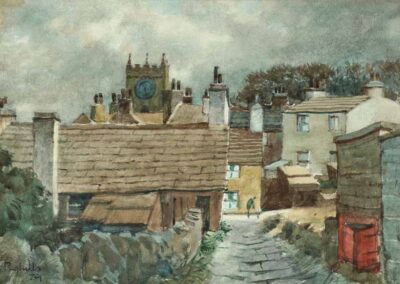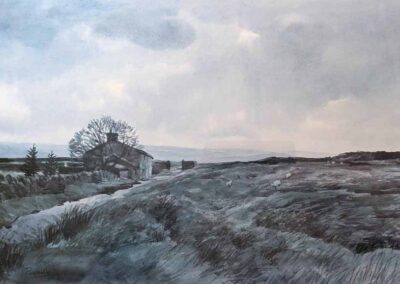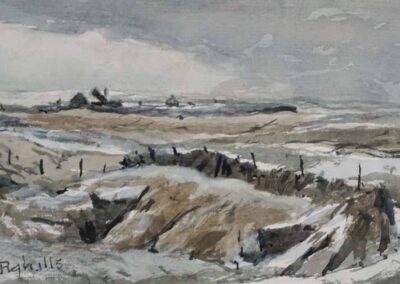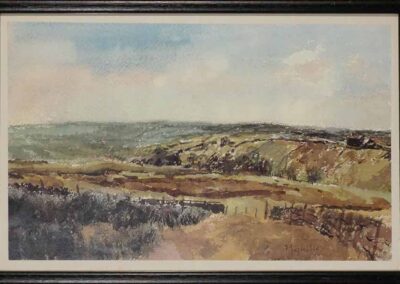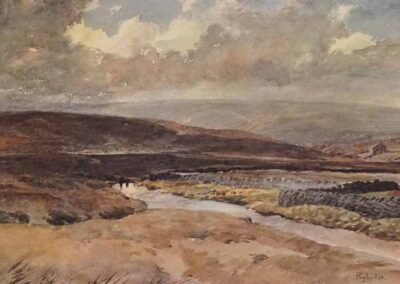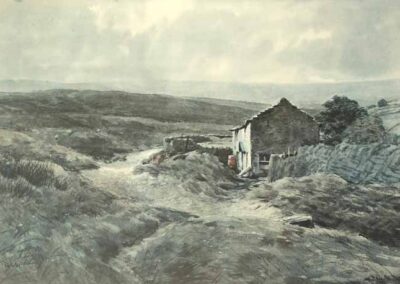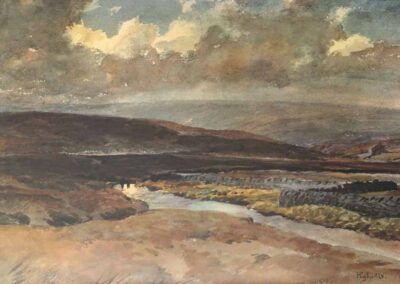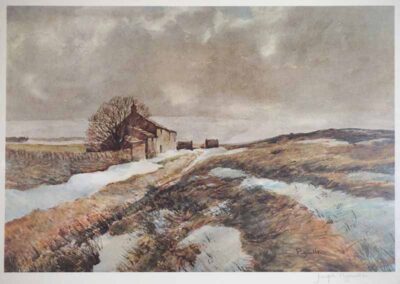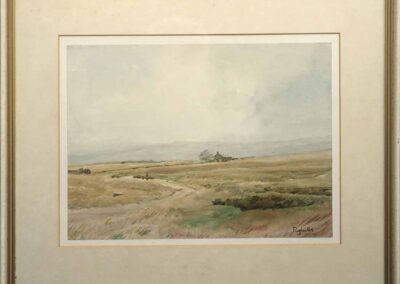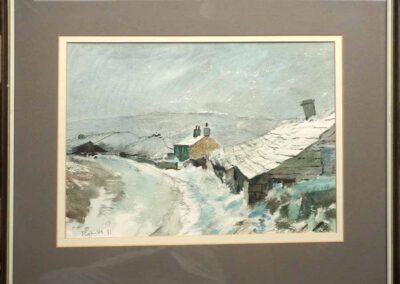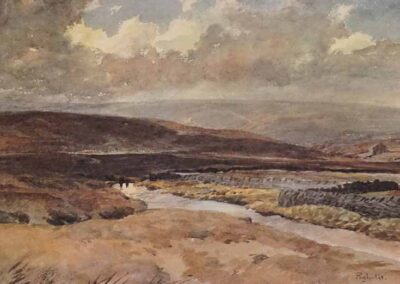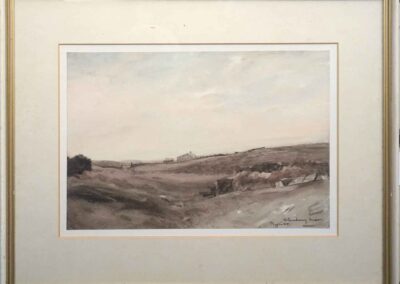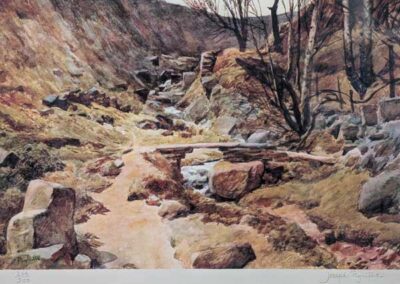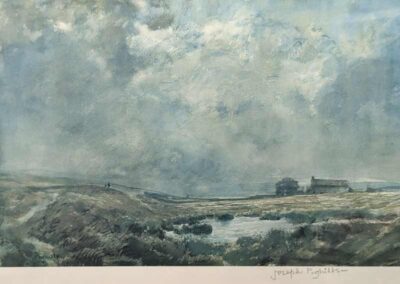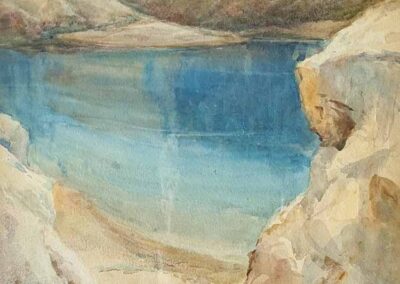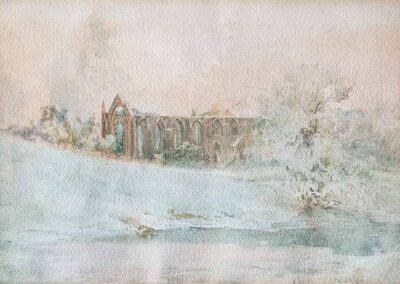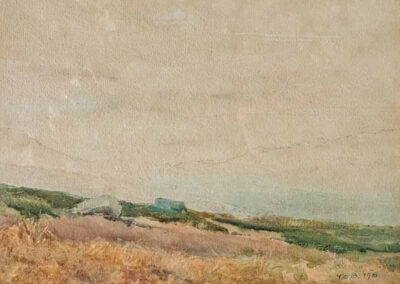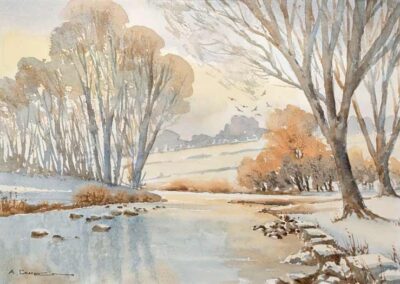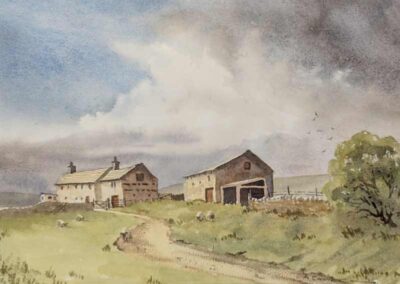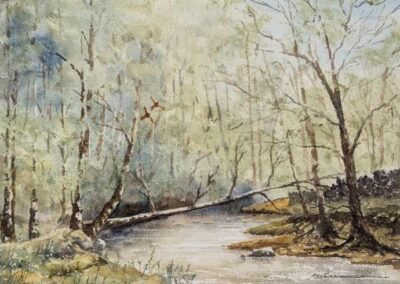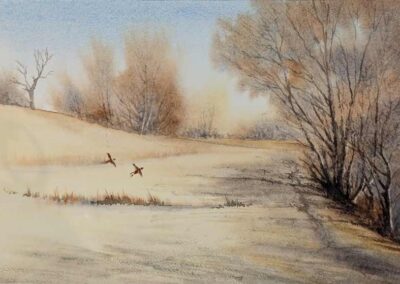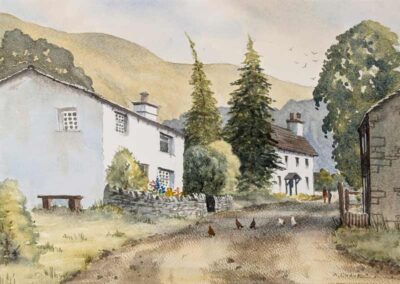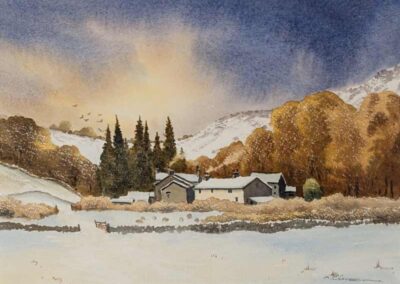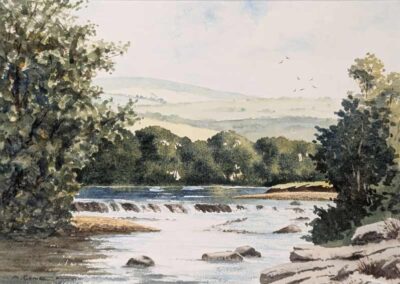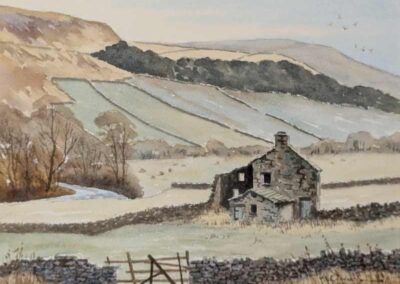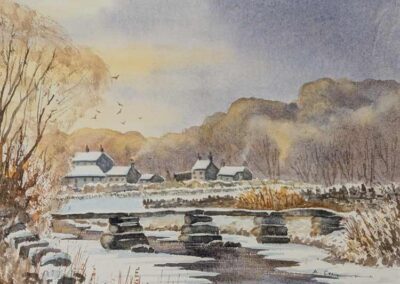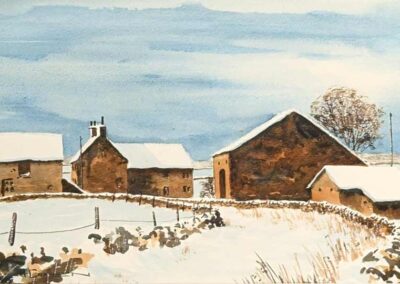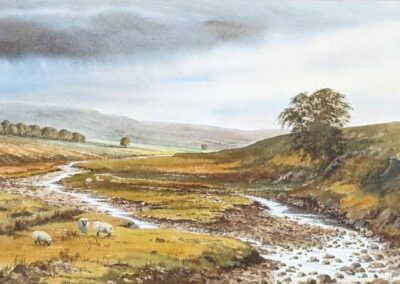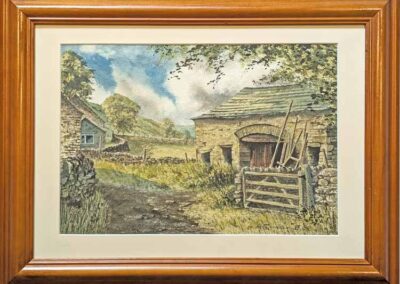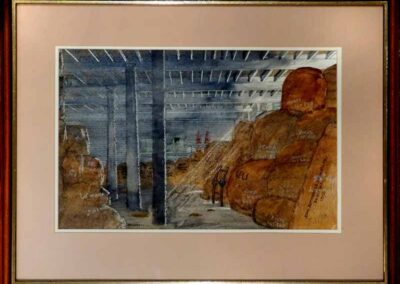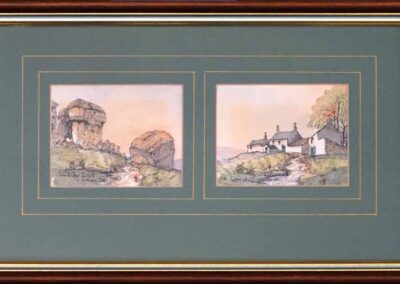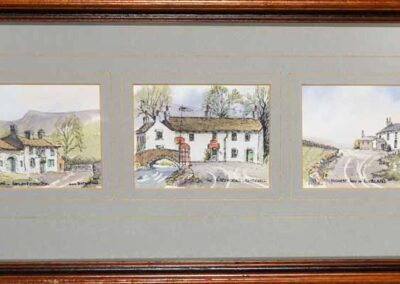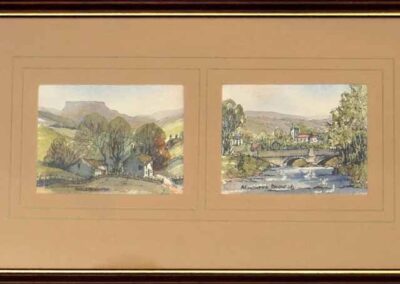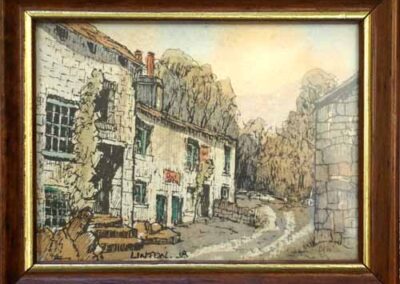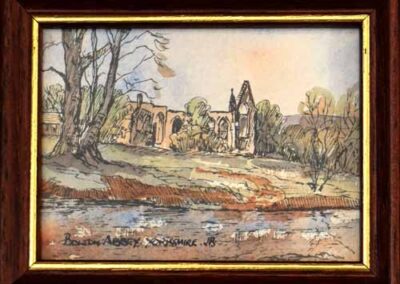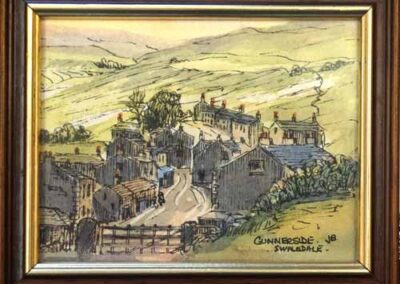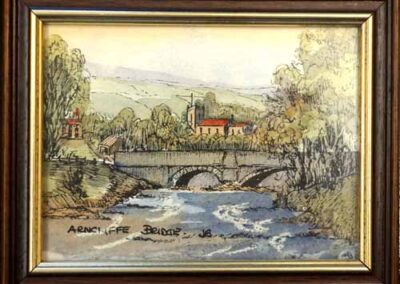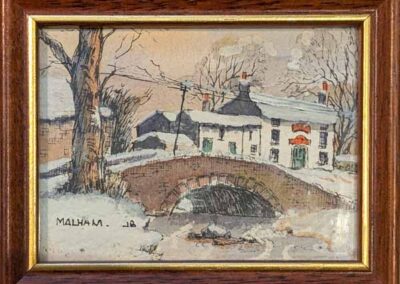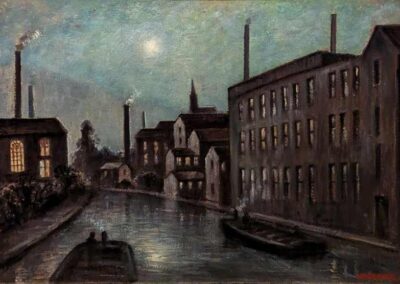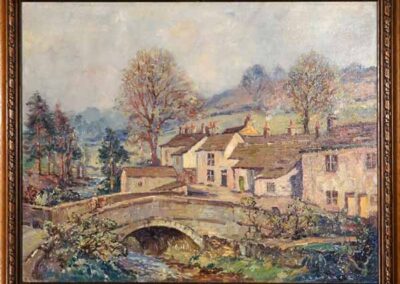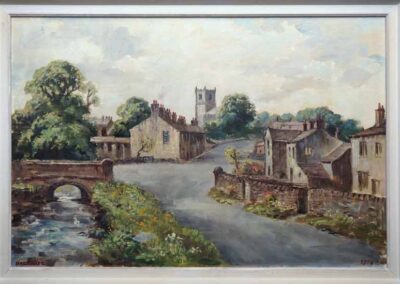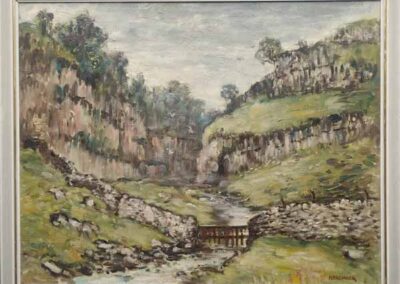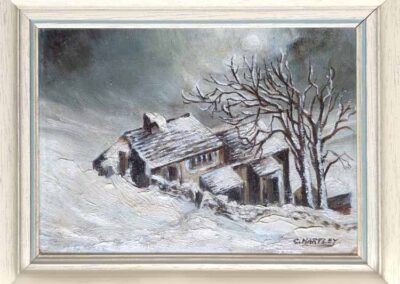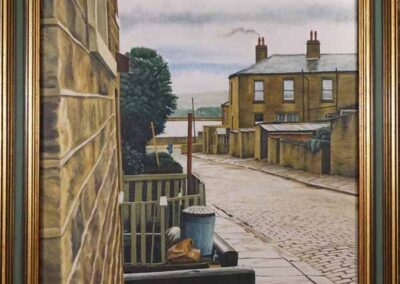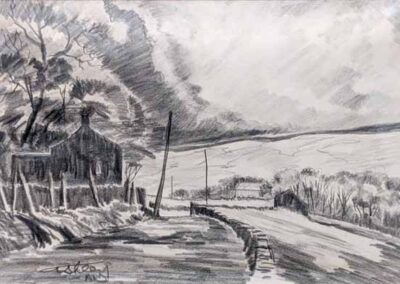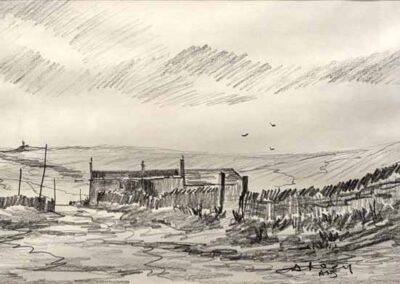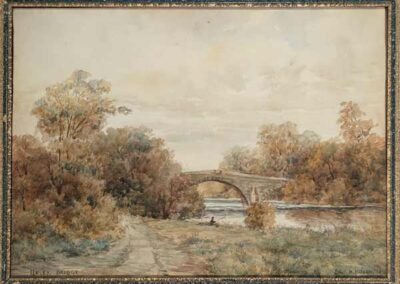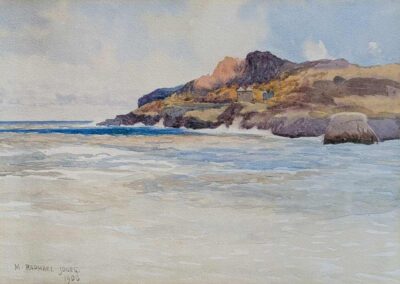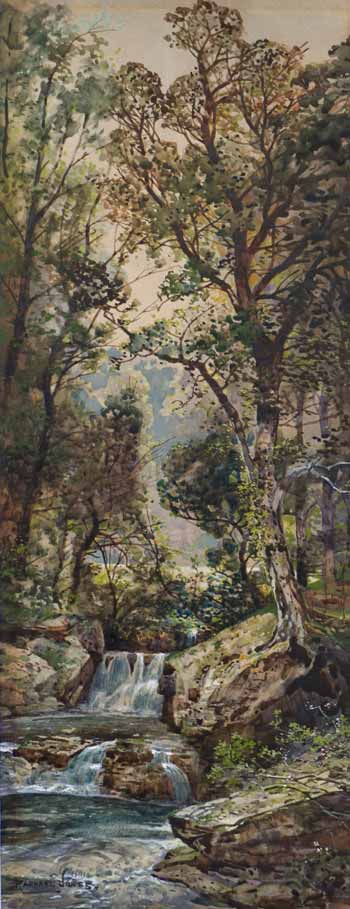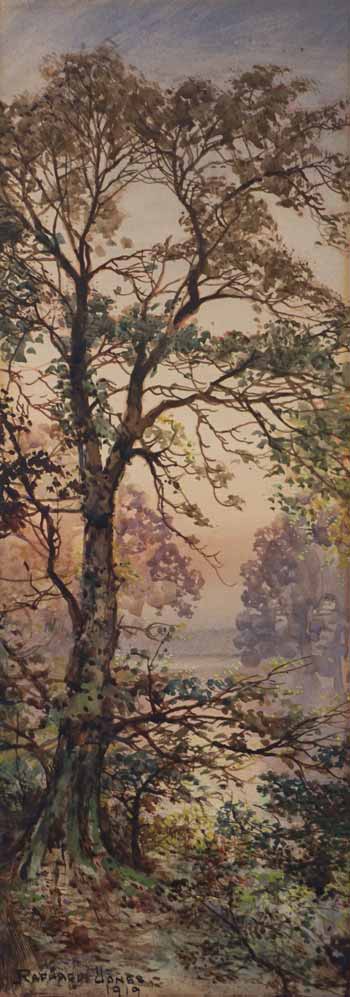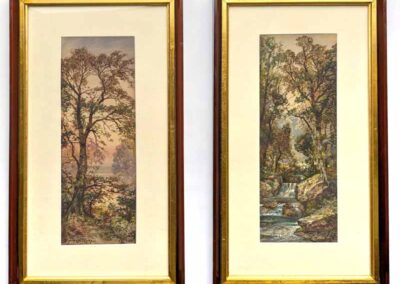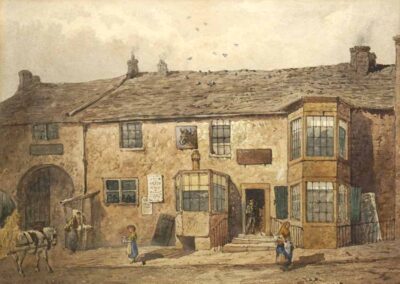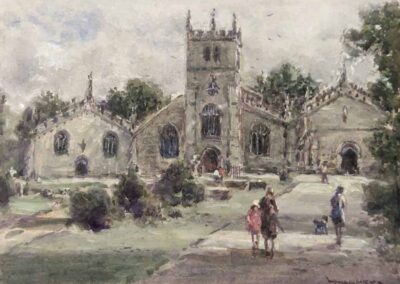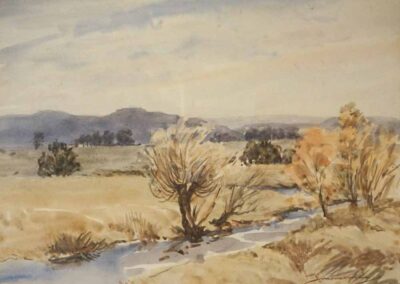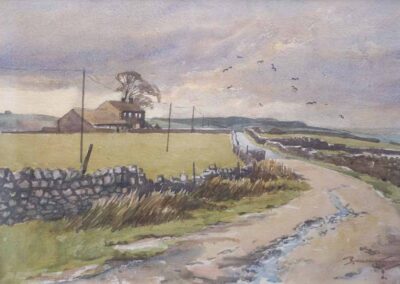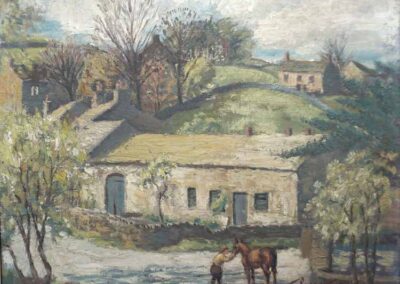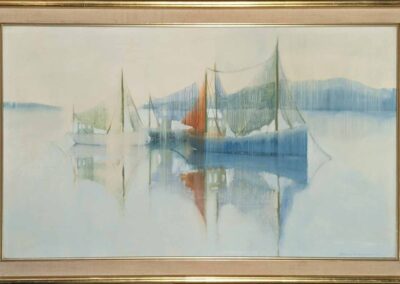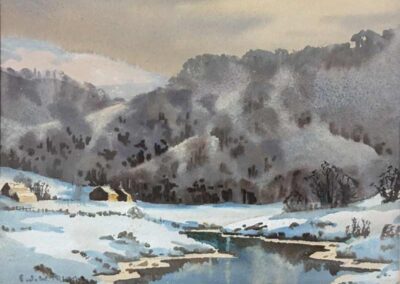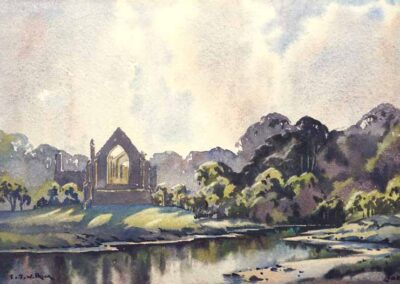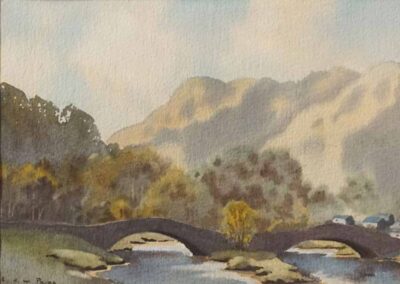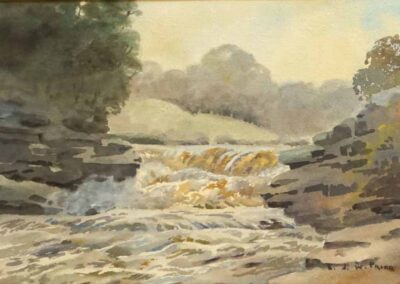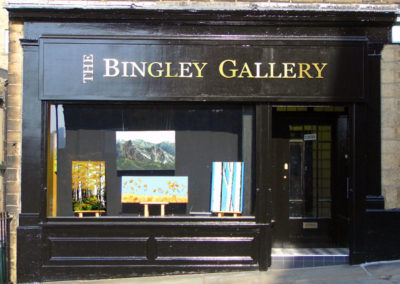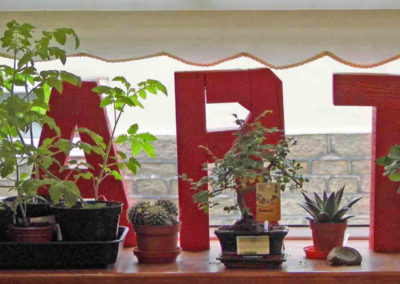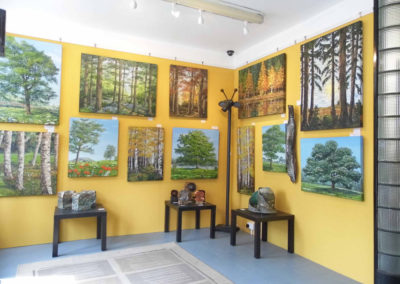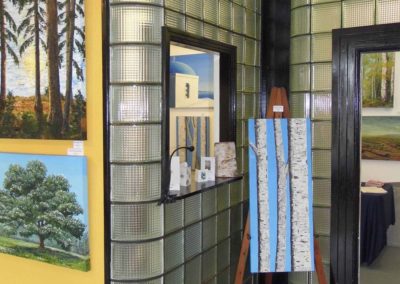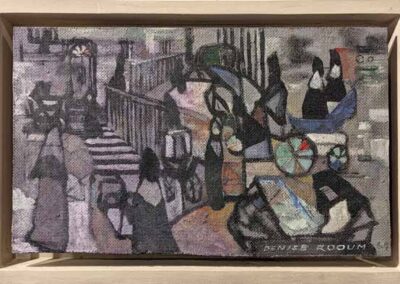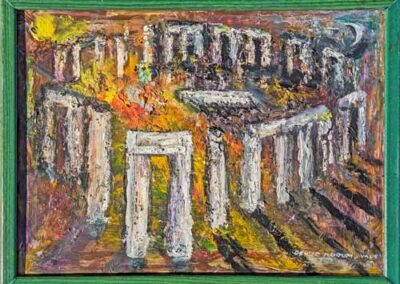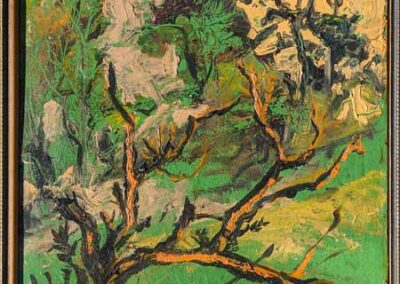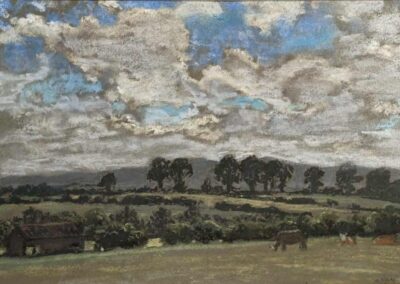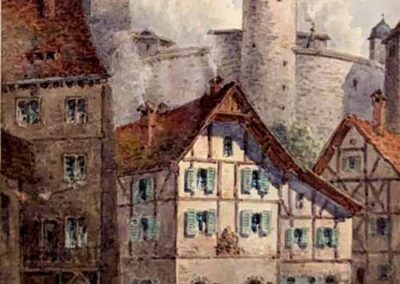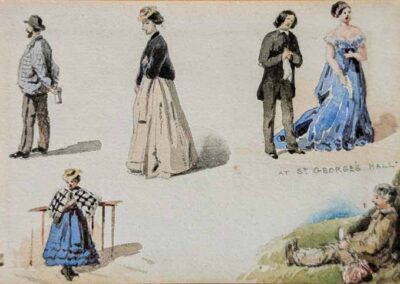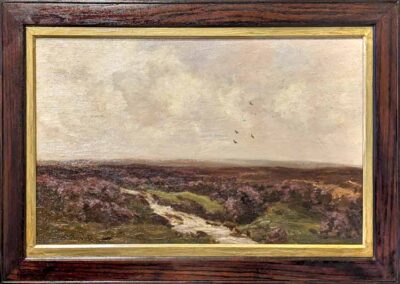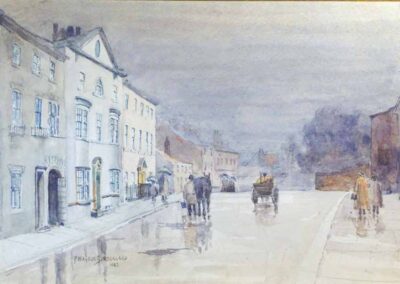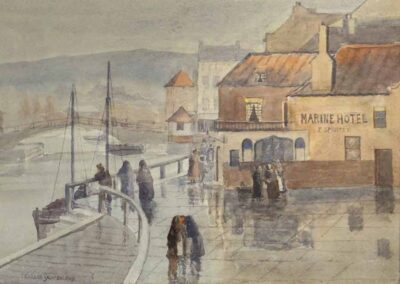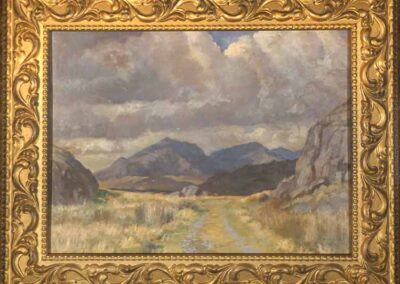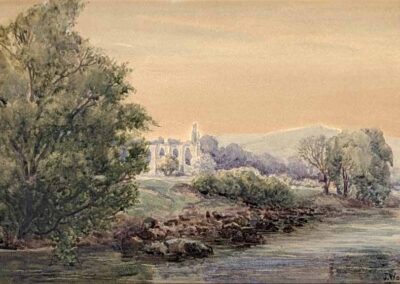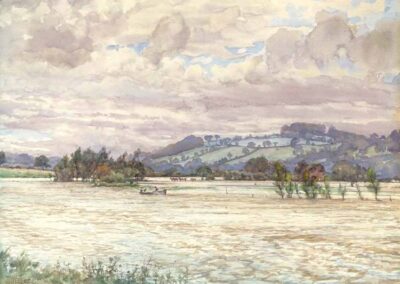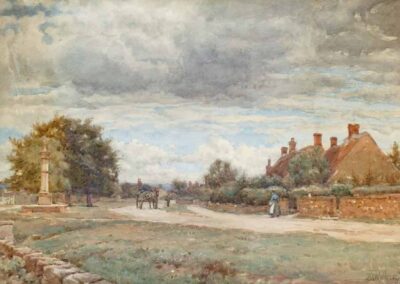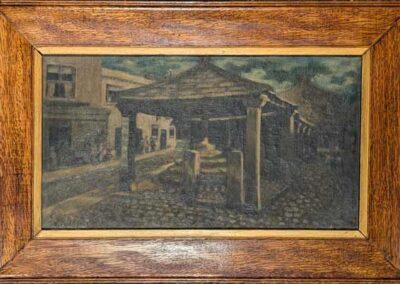30 Jan to 16 Mar Bradford’s Artistic Legacy: Works by earlier artists from the region including Joe Pighills,James Hardaker, Arthur Craven Robert Henry (Joe) Lee and many more.
Robert Henry (Joe) Lee (1915-2007)
Born in Eldwick, Joe attended Bradford College of Art, before going on to study at the Royal College of Art. He was a versatile artist, working in two and three dimensions, including sculpture, painting, collage, and wooden-framed structures, or ‘assemblages’. His subjects from landscape, still-life, abstract and religious subjects to portraits.
As a POW he witnessed the bombing of Dresden, the horrors of which profoundly influenced his life. Returning after the war, he attended the Royal College of Art for a further year before a becoming a teacher of art at a series of colleges and Schools. These included Bingley College of Education, where he was Principal Lecturer in Visual Arts between 1969 and 1979
Robert Henry Lee 1915 to 2007 Bingley RL04 ‘South Landing in Winter ’85 Flamborough’ Acrylic 44x31cm SOLD
Robert Henry Lee 1915 to 2007 Bingley RL06 ‘Pear Run Isle of Lewis’ ink and coloured pencil 33x24cm SOLD
Robert Henry Lee 1915 to 2007 Bingley RL07 ‘Tomb Offering 14C Aztec Museum, Mexico City’ ink and coloured pencil 35x28cm £30
Joseph Pighills 1902-84
Pighills was born and lived his whole life in Oakworth. Attending evening classes at Keighley College of Art, he developed his natural talent – and built a considerable reputation as a ‘painter’s painter’. When ill health required him to give up his work with an engineering company, his art provided a good living. Best known for his stormy views of the moorland near his home.
Joseph Pighills 1901-84 JP65 ‘Thorpe in the Hollows’ Original watercolour 52x32cm framed to 65x44cm £280
Joseph Pighills 1901-84 JP47 ‘Bronte Valley from Far Intake, Haworth Moor’ Watercolour 44x25cm framed to 61x46cm £280
Joseph Pighills 1901-84 JP64 ‘Haworth Main St’ Ltd edition print 7of500 51x28cm framed to 64x42cm £80
Joseph Pighills 1901-84 JP48 ‘Seventeenth Century House, Bilsdale’ Watercolour 38x28cm framed to 40x27cm SOLD
Joseph Pighills 1901-84 JP49 ‘Road to Bronte Falls, Haworth Moor’ Watercolour 52x32cm framed to 67x49cm £300
Joseph Pighills 1901-84 JP63 ‘Moorside, Marsh Nr Oxenhope from Lee Lane’ Waterolour 42x23cm framed to 58x40cm SOLD
Joseph Pighills 1901-84 JP60 ‘Smooker Quarry near Bronte Falls’ watercolour 38x25cm framed to -50x38cm £260
Joseph Pighills 1901-84 JP46 ‘Old Haworth with Jib Lane and Well St’ Watercolour 31x21cm framed to 47x38cm £240
Joseph Pighills 1901-84 JP10 ‘Far Westfield Patchy Snow” Signed print 48.5 x32 in original frame62x52cm £80
Joseph Pighills 1901-84 JP66 ‘Bronte Bridge’ Signed Ltd Edn Print 208 of 500 49x32cm framed to 69x54cm £80
Tom Clifton Butterfield 1856-1937
The Keighley born son of a wool sorter, Tom attended the local Mechanics Institute art class from age 10 and by 13 was winning prizes for his work. In 1881 he gained his art master’s certificate and became assistant art master at the newly opened Keighley School of Art. He became head of the school in 1889 and over the next 20 years greatly expanded the range of subjects offered – many of which were taken up by wounded WW1 soldiers. His own art was predominantly watercolours of landscapes in the immediate Keighley area and he was a strong influence on his students who included Frances Watson Sunderland. Cruelly, for an artist he became blind in later years, but his great ability to remember landscapes allowed him to describe a view with great accuracy.
Tom Clifton Butterfield 1856-1935 (Keighley) TCB04 ‘Old Clay Pit, Keighley’ 1913 watercolour 29x26cm framed to 45x42cm £260
Tom Clifton Butterfield 1856-1935 (Keighley) TCB02 ‘Bolton Priory, Winter Sunset’ 1910 watercolour 36x26cm framed to 53x43cm £200
Arthur Craven 1934-2013
Born in Sutton-in-Craven he moved to live near Haworth. Although he had studied at Keighley Art College for three years, he subsequently worked as a motor mechanics at a local garage. After his national service in the RAF he became an ambulance driver, and it was only later that he became a full time painter, running a gallery in Haworth, then later in Scott St., Keighley. The village of Haworth and its surrounding moorland often feature in his work.
Arthur Craven 1934-2013 ACR17 ‘Winter Sun on the River Skirfare at Litton, Littondale, North Yorks’ Watercolour 35x22cm mounted to51x40.5cm £150
Arthur Craven 1934-2013 ACR15 ‘Barns of Deepdale, Wharfedale’ Watercolour 35x22cm mounted to51x40.5cm £75
Arthur Craven 1934-2013 ACR13 ‘Glen Moidart West Highlands’ Watercolour 35x22cm mounted to51x40.5cm £50
Arthur Craven 1934-2013 ACR14 ‘Lower Sladen Valley Haworth’ Watercolour 35x22cm mounted to51x40.5cm £100
Arthur Craven 1934-2013 ACR08 ‘Stonethwaite, Borrowdale, Cumbria’ Watercolour 35x22cm mounted to51x40.5cm £90
Arthur Craven 1934-2013 ACR09 ‘Grizedale Forest Cumbria’ Watercolour 35x22cm mounted to51x40.5cm £90
Arthur Craven 1934-2013 ACR11 ‘Near Thwaite in Swaledale, N. Yorks’ Watercolour 35x22cm mounted to51x40.5cm £90
Arthur Craven 1934-2013 ACR12 ‘Clapper Bridge at Austwick, N. Yorks’ Watercolour 35x22cm mounted to51x40.5cm £100
Arthur Craven 1934-2013 ACR07 ‘Winter at High Fold Farm, Oxenhope’ Watercolour 30x20cm framed to47x39 £160
Arthur Craven 1934-2013 ACR06 ‘Looking up Kingsdale from Deepdale Farm, North Yorkshire’ Watercolour 61x35cm framed to 83×59 £225
John Butterfield 1913-97
After retiring from his own wool business, Clayton born Butterfield, ran a gallery to sell his own and other’s art, first at Heaton, then Thornton. Best known for his pen and wash Dales scenes.
John Butterfield 1913-97 JBD11 ‘ (1883-1961)’This Was Bradford’s Gold- John Butterfield’s Old Warehouse’ Watercolour & pastel 42x27cm framed to 60x46cm £220
John Butterfield 1913-97 JBD07 ‘Cow and calf and White Wells’ pen and watercolour each3x4in framed to £60
John Butterfield 1913-97 JBD06 ‘ Craven Arms-Appletreewick, Racehorse-Kettlewell, Tan Hill’ 3 3x4in watercolours in 19×8.5in frame £75
John Butterfield 1913-97 JBD08 ‘Ingleborough and Arncliffe Bridge’ pen and watercolour each3x4in framed to £60
James Hardaker 1901 – 1991
A Bingley based artist, who, whilst a capable portrait and abstract painter, relied on landscapes as the mainstay of his business, selling them from his own gallery, initially in Myrtle Place, then Park Road in Bingley just a few yards from the current Gallery, demonstrating that the tradition of artists in our district continues.
James Hardaker 1901-91 JH15 ‘Bingley Canal By Moonlight’ oil on board. Framed to78x53cm cropped SOLD
Christopher Hartley 1903 – 1980
Studied at Keighley Art College and later ran an art materials shop in the town, providing art tuition. He was predominantly an ecclesiastical artist, painting murals for churches in Britain, USA, Ireland and other European. Surviving portable art works seem to be few and far between but his capability is shown by his acceptance as a Fellow of the Royal Society of Arts in 1948.
Stuart Hirst 1950 –
Bradford born artist who followed a foundation course at Bradford College of Art with a degree in Fine Art from Exeter University. Perhaps best known for his wet streets series which typify the Victorian architecture of the district with its York stone flags and setts. From the 1990s Hirst explored other subject matter, particularly more surreal urban fantasies. In recent years he has moved to Scarborough where he runs the Dorothy Rowan Gallery.
Ashley Jackson 1940 –
Not specifically linked to Bradford, with a studio in Holmfirth, but a bit of a Yorkshire icon as an artist and TV personality
Ethel Mary Kitson (1894- 1964)
Born in Bradford, the daughter of a timber merchant she married another Bradford artist Fred Cecil ‘Detail’ Jones in 1925. In the 1939 directory she gives her occupation as Art Mistress and Housewife. I’ve been able to find out nothing about her training of where she worked. One further example of her work, a watercolour view of Whitby came up recently at auction.
Maud Raphael Jones 1891-1956
Born of working class parents, it is unclear where Jones received his artistic training., but artistic success, including exhibition at the Royal Academy and high prices fetched by his work, allowed him to become a professional artist. His apparently feminine name is reputed to have been the result of a dare by his father’s drinking colleagues on his way to the registry office.
Maud Raphael Jones 1863 to1935 MRJ03 ‘Coastal Scene’ Possibly Ravenscar 1906 watercolour Framed to44x54cm £140
Arthur Mc.Arthur 1827-1892
Research by the gallery suggests he was born in France moving to Leicestershire then Nottingham but was based in Bradford in the early 1870s. Many of his views of ‘old’ Bradford date to this time. Some of the works held by the gallery have been found to have numerous notes about the subject in the margins.
We have just the one view in the gallery at the moment, the others are in Carlton Antiques, in Salts Mill, Saltaire
William Manners (1860-1942)
A self taught painter whose work was widely exhibited, including at the Royal Academy and he was elected as a member of the Royal Society of British Artists. Born in Bradford he lived there and in Otley until 1890 when he moved to the lake district.
Percy Monkman 1892- 1986
Born in Bradford, but later moving to Baildon, Monkman’s career working in a bank contrasted strongly with other strands of his life including entertainer, actor and prolific painter of urban Bradford as well as The Dales. His life history has been published by his grandson, Martin Greenwood.
Gerald Parkinson (b Shipley 1926)
Born in Bradford and living at Nabwood Drive Shipley in 1939, Parkinson studied at Bradford School of Art, but later moved to London then East Hoathly Sussex. Many of his subjects are of ships and harbours, perhaps influenced by his time in the royal Navy. His work is characteristically ethereal.
Ebenezer John Woods (Jack) Prior 1914-1988
When his family wool stapling business went into liquidation, Prior converted his painting hobby into a profession. Although largely self-taught, he achieved considerable success, building a strong reputation and, apparently earning a better living than he had in his previous day job. His chosen technique was watercolour and water features in many of his paintings.
EJW (Jack) Prior 1914-1988 JAP02 ‘Grange Bridge Borrowdale’ watercolour 26x18cm framed to 40x33cm £90
Edward Renard 1854-1915
London born Renard studied at the National Art School (which later became the Royal College of Art) in 1882 he was appointed as Head of the Shipley School of Art founded by Titus Salt and was a major figure in the formation of the Yorkshire Union of Artists.
Denise Rooum 1929-2018
Born in Bradford into an artistic, left leaning Baptist family with artistic talent. In her mid-twenties, Denise attended Canterbury College of Art, but subsequently gained a scholarship prize to study fine art at the Chelsea College of Art. With her artist husband Brian Vale she established an art studio at Heaton. She exhibited locally and nationally and her work is found in many collections She clearly had an adventurous attitude to painting, her early work in particular never followed earlier conventions. In addition to painting, she wrote and illustrated books.
Herbert Royle 1870-1958
Born near Manchester, the son of a newspaper shop owner, Royle received training at the Harris institute in Preston and was strongly influenced by John Buxton Knight from whom he also took lessons. He moved to Bolton Abbey in 1918 then from 1924 to Nesfield near Ilkley. Most of his works are rural views of Wharfedale, together with others of the Scottish Highlands. His work is held by many municipal and private collections and remain highly sought.
John Sowden 1838-1926
A Bradford architect turned wealthy property developer who balanced this with the position of Master, then Head of Art at The Mechanics Institute. His own output of paintings was notable in quantity and quality, including portraits of the Bradford well-to-do and, famously, street characters over 300 of which are held by the Bradford museums Service.
William Charles Rushton 1860-1921
This Bingley resident artist’s story is a remarkable one of perseverance in the face of tragedy and hardship. Born in Windhill, his father, a warp dresser died the following year and William went to live with his grandparents. He started to work part time at 9 and full time from 11, as a spinner.
Despite his limited education at 15, he began to write poetry, and the following year, joined a theatrical group as a travelling actor. In 1879, aged 19, he returned home to Shipley work full -time as a wool-sorter in a local mill. However, by 1882 he had abandoned mill work to pursue a freelance career as a poet and artist. Married in 1884 his first daughter died at two in 1888 and his wife in 1896 at which point he re-married and seemingly enjoyed a longer period of domestic stability and artistic success, with his impressionistic paintings.
Frances Watson Sunderland 1866-1949
Living all her life in Keighley, Sunderland studied at the town’s School of Art and went on to teach there also, although her art found favour in exhibitions much further afield. Many of her views are of the local landscape, but the Yorkshire coast was also a popular subject matter, with watercolours in her subtle colour palette.
William Hartley Waddington 1883 – 1961
Born into an affluent family of wool merchants, Waddington lived his early life in Manningham. After graduating from the Slade School of art he moved to the Lake District to paint and teach art.
Joseph West 1881 – 1958
Born in Farnhill, the son of a labourer, West moved to Silsden and earned a living as a house painter but attended classes at the Glusborn School of art and later studied painting through the Yellow Door School of art (Colin Neville suggests this was probably by correspondence). By 1911 he gave his profession as painter artist, with a studio in Cavendish St, Keighley, then later in Silsden, whilst his own reputation as an artist increased.
John Dobby Walker 1863-1925
The son of a Bradford warehouseman, Walker started his working life as coach trimmer and painter at a local coach building firm. After studying art at the Bradford Church Institute, he taught art before becoming a professional watercolour painter, particularly of landscapes. His work is notable for fine detail and good use of colour. Walker exhibited widely, including 16 works at The Royal Academy. He moved to North Yorkshire in later years, but is buried in Nabwood cemetery.
Unclear signature

